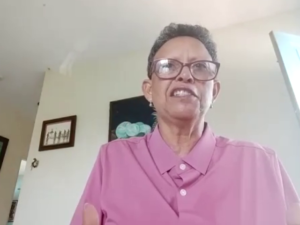Bra Anansi, the Trickster Spider Still Beloved by Belizeans
When it comes to highlighting Belizean culture, many think of rich food, dynamic music, diverse ethnicities displayed throughout the country. However, if you grew up in Belize, then there is a possibility that Belizean folklores were a memorable part of your childhood. In this week’s episode of Kolcha Tuesday, we bring you the stories of Bra Anansi; a popular Caribbean and African character that Belizean authors are still making their own to this day. Here’s News Five’s Britney Gordon with more insight into the world of Bra Anansi.
Britney Gordon, reporting
The tales of the trickster spider, Bra Anansi have been told across the Caribbean for decades. Having originated in West Africa, the character eventually found his way into the region through the transatlantic slave trade. In these stories, Anansi is typically depicted in the role of the underdog, who can outsmart his superiors due to his cunning nature. Roy Davis, who began writing Bra Anansi stories in 1993 says craftiness and deceitfulness are the essence of his characters.

Roy Davis
Roy Davis, Bra Anansi Writer
“The Anansi that I wrote about was he was a trickster, but he wasn’t a bad person. Because the whole idea of the Bra Anansi thing for me was that Bra Anansi represented the underprivileged people, the slaves, so to speak. And Bra Tiger, his adversary, was the slave master and stuff like that, right? And Anansi’s role was to always, he being a smalL creature, compared to Bra Tiger, was to use his brains to outsmart Bra Tiger. So all my stories are centered in that direction. In my opinion, Anansi wasn’t a bad person, wasn’t a bad character. Anansi was like a champion for the people.”
In his stories, Davis often depicted Anasi against Bra Tiger, his adversary and let him come out on top as a symbol for the underprivileged.
 Roy Davis
Roy Davis
“I tried to emphasize that the book is not only for children, it’s for anybody. Children and adults. The stories, what first drew me to the Bra Anansi, Bra Tiger folklore was the fact that it originated from Ghana. It was the African slaves who were brought to the side of, to the side of this world who brought the folklore along with them. And that da weh mek I get interested in it and one ah the thing weh inspire me fi write ney stories.”
 Having written sixteen Anansi stories over his career, Davis is a pioneer in the literary scene, alongside authors such as Sir Colville Young and Adler Ramclam. However, the art of creating a Bra Anansi story is still alive in the culture as new authors emerge and take up the mantle. Sherlet Neal, author of Belizean Storytime, told us about her desire to bring these stories back into the spotlight.
Having written sixteen Anansi stories over his career, Davis is a pioneer in the literary scene, alongside authors such as Sir Colville Young and Adler Ramclam. However, the art of creating a Bra Anansi story is still alive in the culture as new authors emerge and take up the mantle. Sherlet Neal, author of Belizean Storytime, told us about her desire to bring these stories back into the spotlight.

Sherlet Neal
Sherlet Neal, Bra Anansi Author
“So this was a labor of love and it took me over five years to actually publish this storybook. For me, these stories are personal. I grew up in an environment where, of course, we didn’t have electricity. We didn’t have television. And our pastime was stories. And my uncles, my other relatives, I relished listening to those stories, those folklore stories. Of course, Anansi was at the center of a lot of those stories. And so for me, it was nostalgic when I started to put pen on paper. And what I wanted to do was recreate that memory because I don’t see stories like these a lot anymore. And so it was the reason I decided to do Belizean Storytime.”
Neal told us that when creating an Anansi story, his cunningness is the most important part of his personality to remember. To make the stories her own, she depicted Anansi as the trickster that does not always get what he wants.
 Sherlet Neal
Sherlet Neal
“Growing up I always learned of Anansi as the trickster. And I wanted to put a little spin on Anansi, and in most of my stories, I wanted Anansi to get a taste of his own medicine. And so most of the stories have a moral, and in those stories, Anansi outsmarted himself basically. And that was what I wanted to do, especially for younger kids, to let them see that, hey, you can try and outsmart, but hey, somebody is always smarter than you. And so I didn’t want to leave it as Anansi the trickster getting away with stuff. That’s not the lesson I wanted. The lessons I wanted was Anansi is tricky, yes, but there is a lesson to be learned in morality from these stories.”
 Neal’s book was published in 2017 and can still be found in bookstores and libraries alongside the works of Davis and other Anansi authors. However, she explained that she is working towards having the book republished in standardized creole. Sylvia Udz, of the National Kriol Council of Belize spoke explained how they have been working to ensure that Anansi stories are accessible and true to Belizean culture.
Neal’s book was published in 2017 and can still be found in bookstores and libraries alongside the works of Davis and other Anansi authors. However, she explained that she is working towards having the book republished in standardized creole. Sylvia Udz, of the National Kriol Council of Belize spoke explained how they have been working to ensure that Anansi stories are accessible and true to Belizean culture.

Sylvaana Udz
Sylvaana Udz, Creole Linguist
“One ah the first thing that we mih do that mi try and capture some of the Anansi story dem. Dr. Irving Beck back in the 1970s mih come and record and get permission from people like. I think this man neem alive again and if he is, forgive me for saying Adler Ramclam and his Belizeanized versions of these Anansi stories. The word Anansi itself will cu have as Hanasi, Hanansi, so that’s one of the few words with Four variant spellings reflecting different pronunciations that appear standard across the country. And Anansi, we know, we documented, and we really thank Sir Colville Young and people like that for, and Dr. Beck and others for having done some of this work.”
 Even though the Anansi character did not originate in Belize, he has found a home here and by placing him in locations and situations that Belizeans are familiar with, he is a relatable character to read about whether he wins or loses at the end of the story.
Even though the Anansi character did not originate in Belize, he has found a home here and by placing him in locations and situations that Belizeans are familiar with, he is a relatable character to read about whether he wins or loses at the end of the story.
 Sherlet Neal
Sherlet Neal
“This is a compilation of short stories. And in a lot of these stories, we put Anansi in the center of the communities doing everyday stuff, like Anansi is going to church. Anansi celebrates Valentine. Anansi has an encounter with the police. And so I think Anansi is actually at the center of a hurricane. And of course in all of these stories, Anansi is trying to win. To come up, to trick somebody. And the turnaround is always that he doesn’t succeed. Or he thinks he does and in the end he doesn’t succeed.”
Davis reflected on his time writing Anansi with pride and fondness, highlighting the laughter he was able to bring to people as one of his great joys.
 Roy Davis
Roy Davis
“As I tell you, I’m a creative writer and I know how to create plots. I just use my imagination and I just come up with whatever. Plots I needed and they were all meant to create laughter, if you read any of my story and make you laugh I guarantee that because it has happened before, so it was easy for me to create these plots He’s very easy. That’s something I took pleasure in doing.”
An if di pin neva ben, di stoari noh mi wahn en. Britney Gordon for News Five.






Facebook Comments